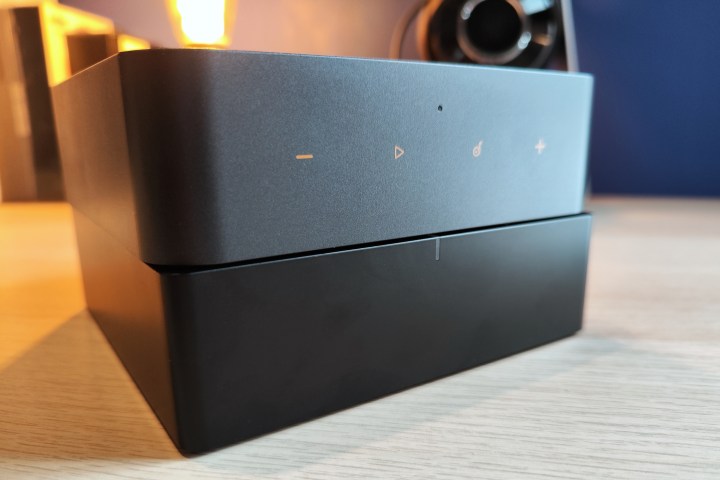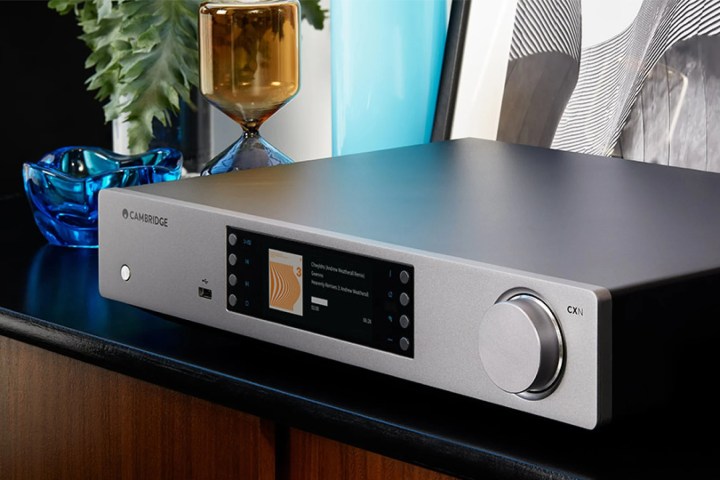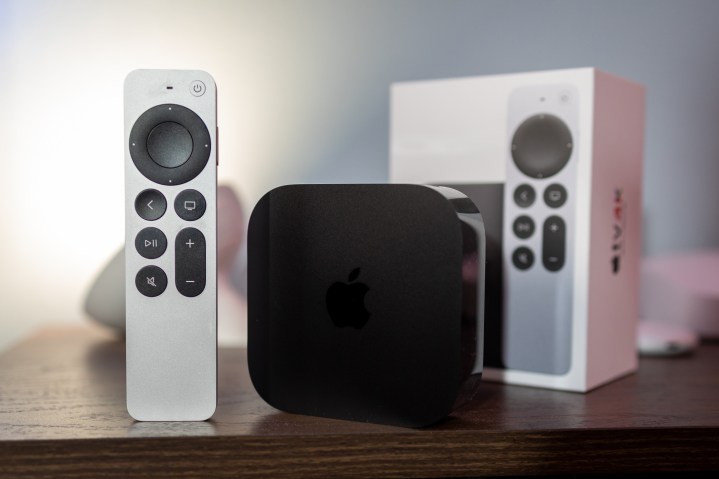
Whether your main source of music comes from old-school physical media formats such as CDs and vinyl records, or you’ve fully embraced the digital music revolution and get all your tunes from music streaming services like Spotify, Apple Music, or Tidal, there’s a wide range of music setups out there that can sometimes make getting all that music to your ears a little complicated.
And while you may have a sweet old integrated amplifier and speakers for revolving your records, one of the best ways to bring your digital audio and online streaming services to that, or any traditional hi-fi system, is by adding a dedicated network music streamer.
A network music streamer is an internet-connected hardware component that streams your favorite digital music using an internet connection. A good network music streamer is easy to use, compatible with several file formats and music streaming services, and will ensure your digital music sounds good to appease both casual listeners and esteemed decibel sages.
There’s a lot to learn about these components, though, so let’s get started with some of the basics.
What can you expect from a network music streamer?

Network music streamers are available from big-name brands such as Sonos, Cambridge Audio, Naim, NAD, Yamaha, and Technics, as well as from smaller brands like Wiim and Audioengine. They come in all shapes and sizes from compact paperback novel size to that of a Blu-ray player or AV receiver. Music streamers include a variety of connectivity options, such as digital and analog audio, USB ports, XLR hookups, Bluetooth, AirPLay, Chromecast, and connect to the internet either by Wi-Fi, Ethernet, or both. In other words, there’s no shortage of ways to connect a music streamer to devices from receivers and amplifiers to powered speakers, smartphones, headphones, TVs, and more.
Once you have the streamer connected to your audio system and paired to your Wi-Fi network (or hardwired to it for the fastest and most stable connection), you’ll be able to use it to listen to music using platforms like Spotify, Apple Music, Tidal, Qobuz, Deezer, and several others. With USB connectivity, many music streamers will also allow you to plug in a USB flash drive or external hard drive that contains music files.
Depending on what type of network music streamer you own, you may also be able to access music from a compatible network-attached storage device (NAS) or computer on the same Wi-Fi network as the network streamer. There are also music streamers that support multi-room audio, such as Sonos and Bluesound, and/or can interface with other streamers from the same brand, which (in most cases) will allow you to enjoy multi-room audio by having Device A wirelessly linked up to Device B, C, D, etcetera.
You’ll also be able to find music streamers with built-in storage options. This is especially convenient if you want to keep all your hi-res files located on one easy-to-access drive.
Why should you buy a network music streamer?

There are a number of benefits to owning a network music streamer, even if there may be a bit of a learning curve to using it.
First and foremost, a music streamer is going to have a far more powerful and efficient DAC (digital-to-analog converter) than most everyday music-listening devices, such as iPhones and Android mobile devices and our home computers. A DAC has the very important job of converting all the digital data that it receives from sources like audio-streaming services and hard disk files into analog signals so we can hear them.
The types of DACs that are built into network music streamers are usually designed to handle the much tougher job of decoding hi-res audio formats. We’re talking CD quality and beyond, including formats like FLAC, DSD, WAV, AIFF, ALAC, and other top-shelf audio content. And because they’re internet-connected, either via LAN or Wi-Fi, the bandwidth ensures the full potential of the music. The end result: The cleanest-sounding audio possible, regardless of the source.
And do note that not all DACs are created equal. For example, a music streamer like the budget-friendly Wiim Mini is great for streaming across different platforms, but the streamer’s internal DAC may not be as good as one you’d find in a dedicated AV receiver or amplifier. But in the case of a device like the Cambridge Audio CXN, this Cambridge streamer has two internal Wolfson DACs, which is going to give you bright and detailed audio quality that is leaps and bounds beyond the Wiim Mini’s capabilities (and that of many other AV components).
Another benefit of network music streamers is that many of them have interfaces and apps that house all of your sources and components — streaming services, line inputs, NAS drives, whole-home speakers — so they can all be selected and controlled from one unified place, like a smartphone or computer. Many of them also have physical controls and LED screens you can access, too.
What should you know before buying a network music streamer?

When investing in any new AV component, especially something like a network music streamer, it’s good to decide what criteria are most important to you, as it can vary from one user to the next. Here are some thinking points that we believe most folks will share common ground on.
Budget
The age-old question of “How much are you willing to spend?” will definitely play into your music streamer purchase. Are you looking to get away with spending as little as possible on a device that delivers bare-bones functionality, or is money no object and you want your music streamer to be packed with the best in audio-processing tech and features?
Generally speaking, network music streamers range in price from just over $100 to several thousand dollars. And while the adage of “you get what you pay for” definitely plays a part here, there are a number of products that punch well above their weight from a cost-to-quality point of view, one of which is the excellent Wiim Pro that’s just $150.
Sound quality
Now, for the most part, most network music streamers are going to deliver at least CD-level sound quality at 16-bit/44.4kHz. But if hi-res lossless content and 24-bit Tidal or Apple Music jam sessions are going to be everyday requirements, you’ll want to make sure you’re purchasing a music streamer that can handle these higher-end formats and services.
Compatibility
While most network music streamers can handle a diverse array of AV connectivity and streaming platforms, you’ll want to make sure that the streamer you invest in is going to play nicely with your existing receiver, amplifier, speakers, etc.
Furthermore, Bluetooth and Wi-Fi compatibility is pretty standard across the board, but only certain network music streamers may support higher-end listening platforms (like Tidal and Qobuz) and/or the ability to use network sharing to access tracks and playlists on your computer or an NAS.
User interface
It’s always nice when the network music streamer you’ve purchased has its own dedicated interface with native support for popular platforms like Apple Music and Tidal built-in, along with features like an LED touchscreen, buttons, a remote control, and a downloadable app with customizations a-plenty. Sonos is a company that does this extremely well.
These full-component streamers with their own apps allow you access to the full music quality the service is capable of, whereas a so-called “endpoint” streamer must be controlled through a device, usually via something like AirPlay, Chromecast, or even Bluetooth, which can limit the sound quality.
For example, Sonos’ native Apple Music integration supports the service’s quality, up to 24-bit/48kHz lossless. But with a network streamer that doesn’t have native Apple Music, you’d need to use AirPlay or Bluetooth to send Apple Music from your phone to the streamer, limiting the quality to, say, 16-bit-48kHz, which, to be honest, is still pretty good, but keep this in mind if you’re a more discerning audiophile. Also, when you leave the house or go out of range of the network streamer, your device disconnects and the music stops. Chromecast, it’s worth noting, is capable of up to 24-bit/96kHz with compatible devices.
Are there any network music streamer alternatives?

A network music streamer can be a pricy purchase, but is there any other way to get high-quality audio playing through your speakers or surround sound, without forking over hundreds of dollars? The simple answer is yes.
Pretty much any solid streaming device, like the Apple TV 4K (2022) or Chromecast with Google TV, will give you access to various music-streaming platforms. You’ll just need to make sure that you connect these components to your AV system, whether you’re rocking an awesome soundbar or a complete 7.1.2 Dolby Atmos configuration.
For a device like the Apple TV 4K, the Tidal app can be downloaded and installed directly to the device, so subscribers to the service won’t need to use AirPlay or Bluetooth to beam music from their phone or tablet to the Apple TV.
Parting thoughts
A solid network music streamer doesn’t need to cost a fortune, but they’re a great way to bring high-quality and easily-accessible music, podcasts, and whatever else your services offer to your music setup, whether that’s a vintage receiver and speaker, modern integrated amplifier, or a set of powered speakers. Now that you’re armed with some knowledge of what a network music streamer is and what you might want to look for in one, we have some great suggestions for you in our best network music streamers roundup. Happy network streaming.
Services Marketplace – Listings, Bookings & Reviews
